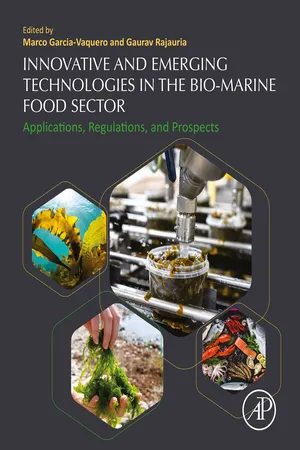
Innovative and Emerging Technologies in the Bio-marine Food Sector
Applications, Regulations, and Prospects
- 554 pages
- English
- ePUB (mobile friendly)
- Only available on web
Innovative and Emerging Technologies in the Bio-marine Food Sector
Applications, Regulations, and Prospects
About This Book
Innovative and Emerging Technologies in the Bio-marine Food Sector: Applications, Regulations, and Prospects presents the use of technologies and recent advances in the emerging marine food industry. Written by renowned scientists in the field, the book focuses primarily on the principles of application and the main technological developments achieved in recent years. It includes technological design, equipment and applications of these technologies in multiple processes. Extraction, preservation, microbiology and processing of food are extensively covered in the wide context of marine food products, including fish, crustaceans, seafood processing waste, seaweed, microalgae and other derived by-products.
This is an interdisciplinary resource that highlights the potential of technology for multiple purposes in the marine food industry as these technological approaches represent a future alternative to develop more efficient industrial processes. Researchers and scientists in the areas of food microbiology, food chemistry, new product development, food processing, food technology, bio-process engineers in marine based industries and scientists in marine related areas will all find this a novel resource.
- Presents novel innovative technologies in the Bio-marine food sector, including principles, equipment, advantages, disadvantages, and future technological prospects
- Explores multi-purpose uses of technologies for extraction, functional food generation, food preservation, food microbiology and food processing
- Provides industrial applications tailored for the marine biological market to foster new innovative applications and regulatory requirements
Frequently asked questions
Information
Table of contents
- Cover image
- Title page
- Table of Contents
- Copyright
- Contributors
- Chapter 1: Overview of the application of innovative and emerging technologies in the bio-marine food sector
- Chapter 2: Regulations on the use of emerging technologies and bio-marine food products
- Chapter 3: Equipment and recent advances in ultrasound technology
- Chapter 4: Ultrasound-assisted extraction of proteins and carbohydrates
- Chapter 5: Ultrasound-assisted extraction of lipids, carotenoids, and other compounds from marine resources
- Chapter 6: Other ultrasound-assisted processes
- Chapter 7: Equipment and recent advances in pulsed electric fields
- Chapter 8: Pulsed electric fields for the extraction of proteins and carbohydrates from marine resources
- Chapter 9: Pulsed electric fields for the extraction of lipids, pigments, and polyphenols from cultured microalgae
- Chapter 10: Other pulse-assisted processes for the bio-marine food sector
- Chapter 11: Equipment and recent advances in supercritical fluids extraction
- Chapter 12: Extraction of carbohydrates and proteins from algal resources using supercritical and subcritical fluids for high-quality products
- Chapter 13: Supercritical fluid extraction of lipids, carotenoids, and other compounds from marine sources
- Chapter 14: Other supercritical fluid processing
- Chapter 15: Equipment and recent advances in microwave processing
- Chapter 16: Microwave-assisted extraction of proteins and carbohydrates from marine resources
- Chapter 17: Microwave-assisted extraction of lipids, carotenoids, and other compounds from marine resources
- Chapter 18: Other microwave-assisted processes: Microwaves as a method ensuring microbiological safety of food
- Chapter 19: Extraction of high-value compounds from marine biomass via ionic liquid-based techniques
- Chapter 20: Application of pressurized liquids to extract high-value compounds from marine biomass
- Chapter 21: Application of plasma technologies for food preservation
- Chapter 22: High-pressure processing for food preservation
- Index